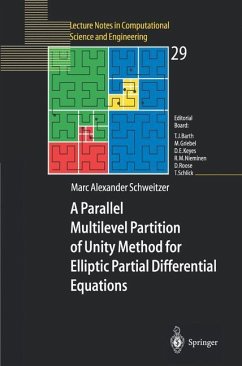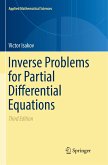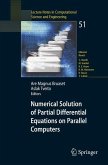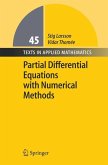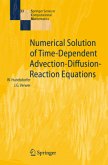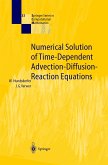The numerical treatment of partial differential equations with meshfree discretization techniques has been a very active research area in recent years. Up to now, however, meshfree methods have been in an early experimental stage and were not competitive due to the lack of efficient iterative solvers and numerical quadrature. This volume now presents an efficient parallel implementation of a meshfree method, namely the partition of unity method (PUM). A general numerical integration scheme is presented for the efficient assembly of the stiffness matrix as well as an optimal multilevel solver for the arising linear system. Furthermore, detailed information on the parallel implementation of the method on distributed memory computers is provided and numerical results are presented in two and three space dimensions with linear, higher order and augmented approximation spaces with up to 42 million degrees of freedom.
the solution or its gradient. These new discretization techniques are promising approaches to overcome the severe problem of mesh-generation. Furthermore, the easy coupling of meshfree discretizations of continuous phenomena to dis crete particle models and the straightforward Lagrangian treatment of PDEs via these techniques make them very interesting from a practical as well as a theoretical point of view. Generally speaking, there are two different types of meshfree approaches; first, the classical particle methods [104, 105, 107, 108] and second, meshfree discretizations based on data fitting techniques [13, 39]. Traditional parti cle methods stem from physics applications like Boltzmann equations [3, 50] and are also of great interest in the mathematical modeling community since many applications nowadays require the use of molecular and atomistic mod els (for instance in semi-conductor design). Note however that these methods are Lagrangian methods; i. e. , they are based On a time-dependent formulation or conservation law and can be applied only within this context. In a particle method we use a discrete set of points to discretize the domain of interest and the solution at a certain time. The PDE is then transformed into equa tions of motion for the discrete particles such that the particles can be moved via these equations. After time discretization of the equations of motion we obtain a certain particle distribution for every time step.
the solution or its gradient. These new discretization techniques are promising approaches to overcome the severe problem of mesh-generation. Furthermore, the easy coupling of meshfree discretizations of continuous phenomena to dis crete particle models and the straightforward Lagrangian treatment of PDEs via these techniques make them very interesting from a practical as well as a theoretical point of view. Generally speaking, there are two different types of meshfree approaches; first, the classical particle methods [104, 105, 107, 108] and second, meshfree discretizations based on data fitting techniques [13, 39]. Traditional parti cle methods stem from physics applications like Boltzmann equations [3, 50] and are also of great interest in the mathematical modeling community since many applications nowadays require the use of molecular and atomistic mod els (for instance in semi-conductor design). Note however that these methods are Lagrangian methods; i. e. , they are based On a time-dependent formulation or conservation law and can be applied only within this context. In a particle method we use a discrete set of points to discretize the domain of interest and the solution at a certain time. The PDE is then transformed into equa tions of motion for the discrete particles such that the particles can be moved via these equations. After time discretization of the equations of motion we obtain a certain particle distribution for every time step.

